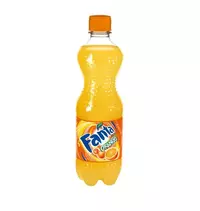Fanta

Fanta belongs to the line of carbonated drinks produced by the famous world corporation The Coca-Cola Company. The modern drink Fanta differs from its counterparts not only in color, taste and aroma, but also in composition. This drink refers to non-alcoholic and cool. However, it cannot be said that Fanta perfectly removes thirst, rather the opposite.
The story of Fanta is interesting and unusual in comparison with other drinks of the American soda manufacturer. During World War II, an embargo on the supply of raw materials for Coca-Cola was imposed on the territory of fascist Germany. However, the head of German production, Ger Kite, was not at a loss and found a way out of this situation.
Fanta line-up
The original composition of Fanta included the following ingredients: apple cake or squeeze and milk whey. These days, the Fanta line-up has nothing to do with that long-standing German drink. The first Fanta was yellow. For almost 20 years, the German Fanta was an independent brand in Germany, and only in the 60s of the last century did the main division of The Coca-Cola Company buy the name. Since then, Fanta has begun to differ in composition and appearance from the original version of the drink.
The Americans made the right choice and the complete rebranding allowed the drink to enter the top three sales leaders around the world. Moreover, the company's advertising and marketing specialists spent not a single decade that the history of the fascists' participation in the creation of the Fanta drink was forgotten. Nevertheless, only in 2008 The Coca-Cola Company released a new block view of Fanta.
Fanta species
Today you can find the following types of Fanta in sales: orange, fruit, grape, lemon, Fanta with grapefruit and blackberries, as well as an apple drink. The company's technologists are constantly working on new tastes in the product line. If we talk about the dangers of Fanta, then we need to pay attention primarily to the composition of the drink, which is similar to similar products, which are now flooded with the market.
Harm of Fanta
Around the world, in addition to Fanta itself, there are about 80 more companies that produce drinks similar to the original. Therefore, Fanta does no less harm than other sweet sodas that our children love so much. Fanta causes harm to the human body, and even more so to children, because it contains a large amount of sugar and a number of food additives, which include dyes, preservatives, as well as acids. Doctors and nutritionists strongly recommend minimizing the consumption of sugary fizzy drinks, including Fanta.
232.5 kCal
Energy value (Ratio of proteins, fats, carbohydrates - ju):
Proteins: 0 g (~ 0 kCal)
Fats: 0 g (~ 0 kCal)
Carbohydrates: 56.3 g (~ 225 kCal)
Energy ratio (b | y): 0% | 0% | 97%
 Español
Español Français
Français Português
Português Русский
Русский 简体中文
简体中文 繁體中文
繁體中文 日本語
日本語 한국어
한국어 العربية
العربية Türkçe
Türkçe Қазақ
Қазақ Deutsch
Deutsch Italiano
Italiano Українська
Українська
